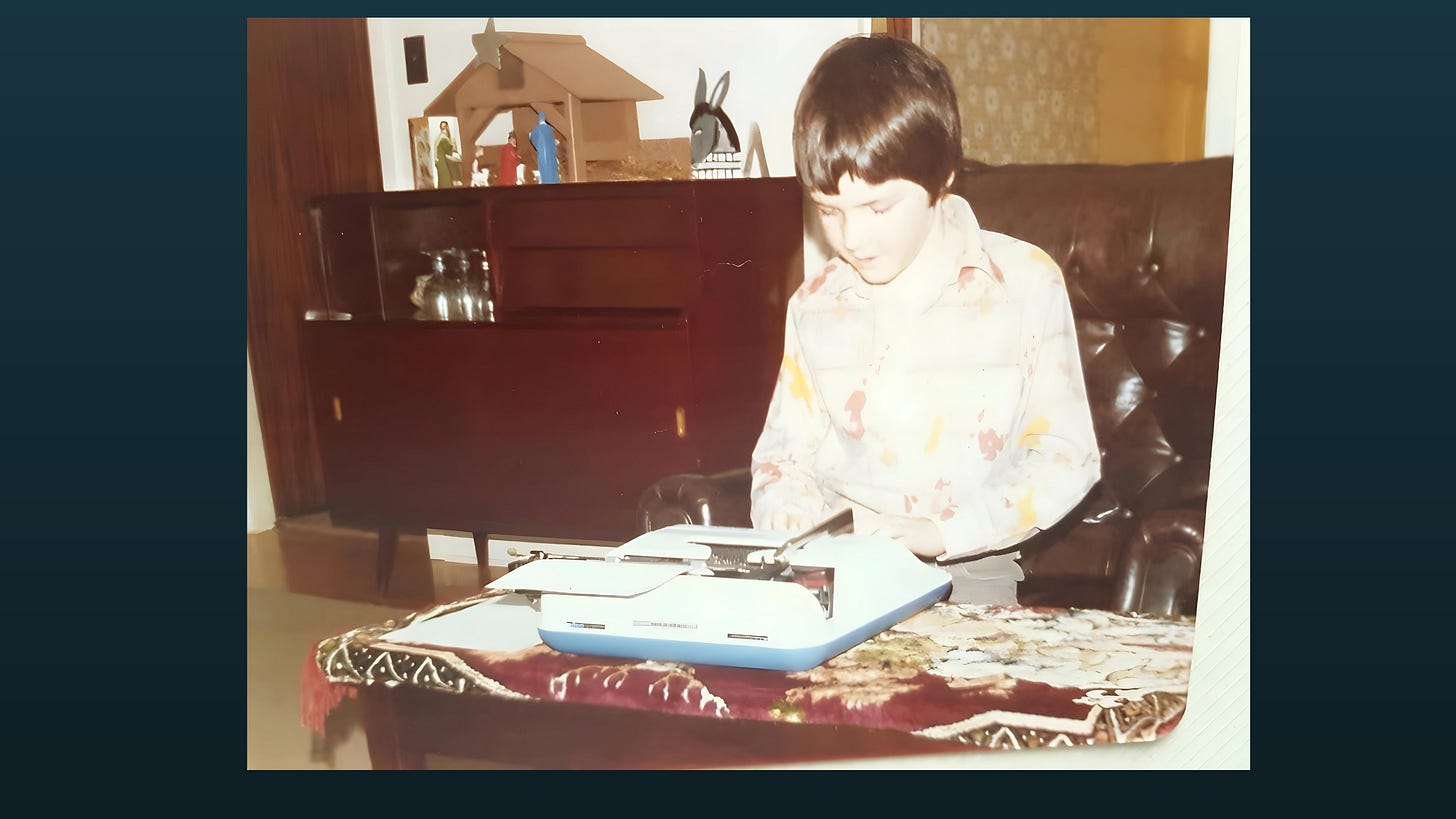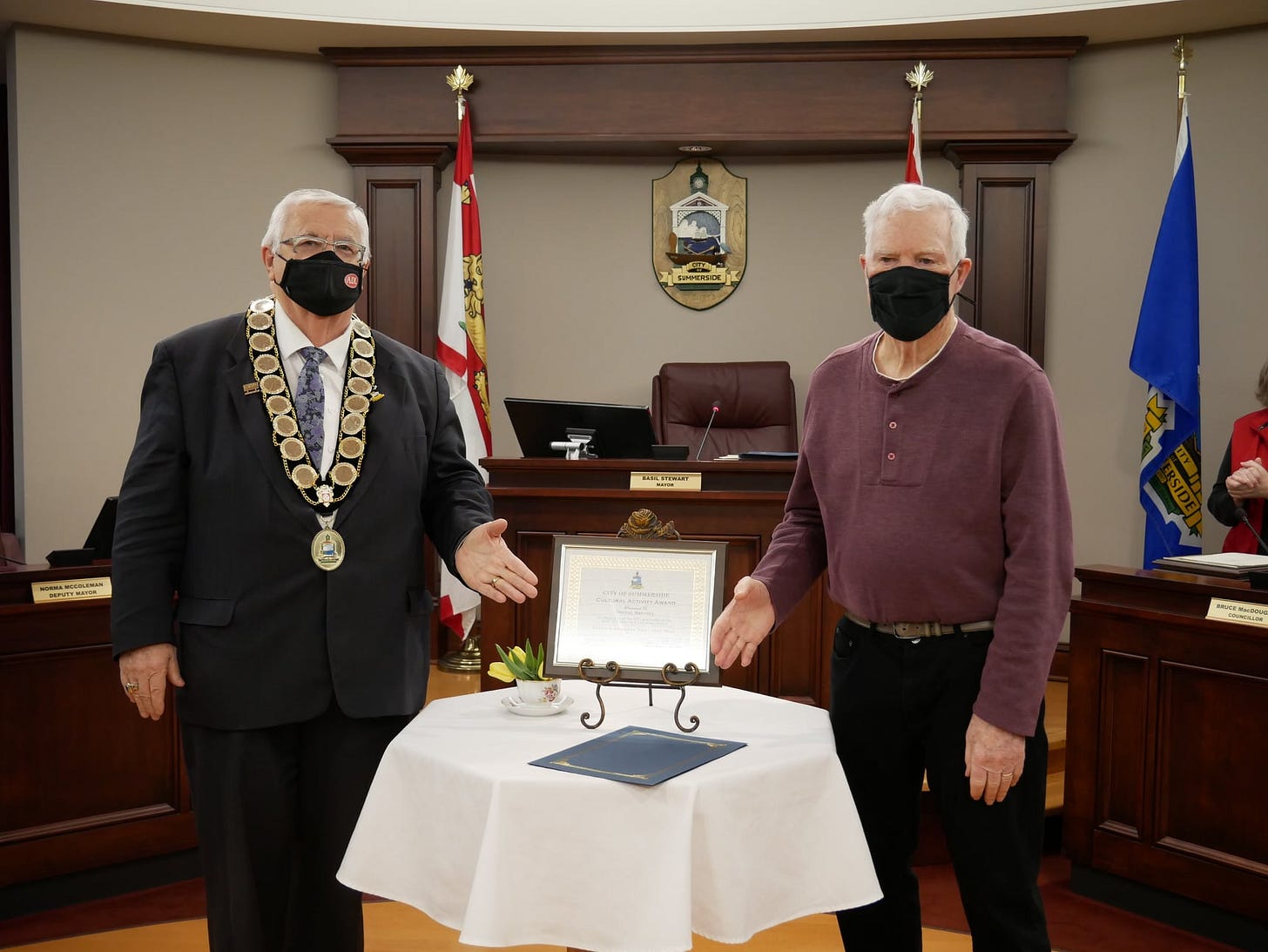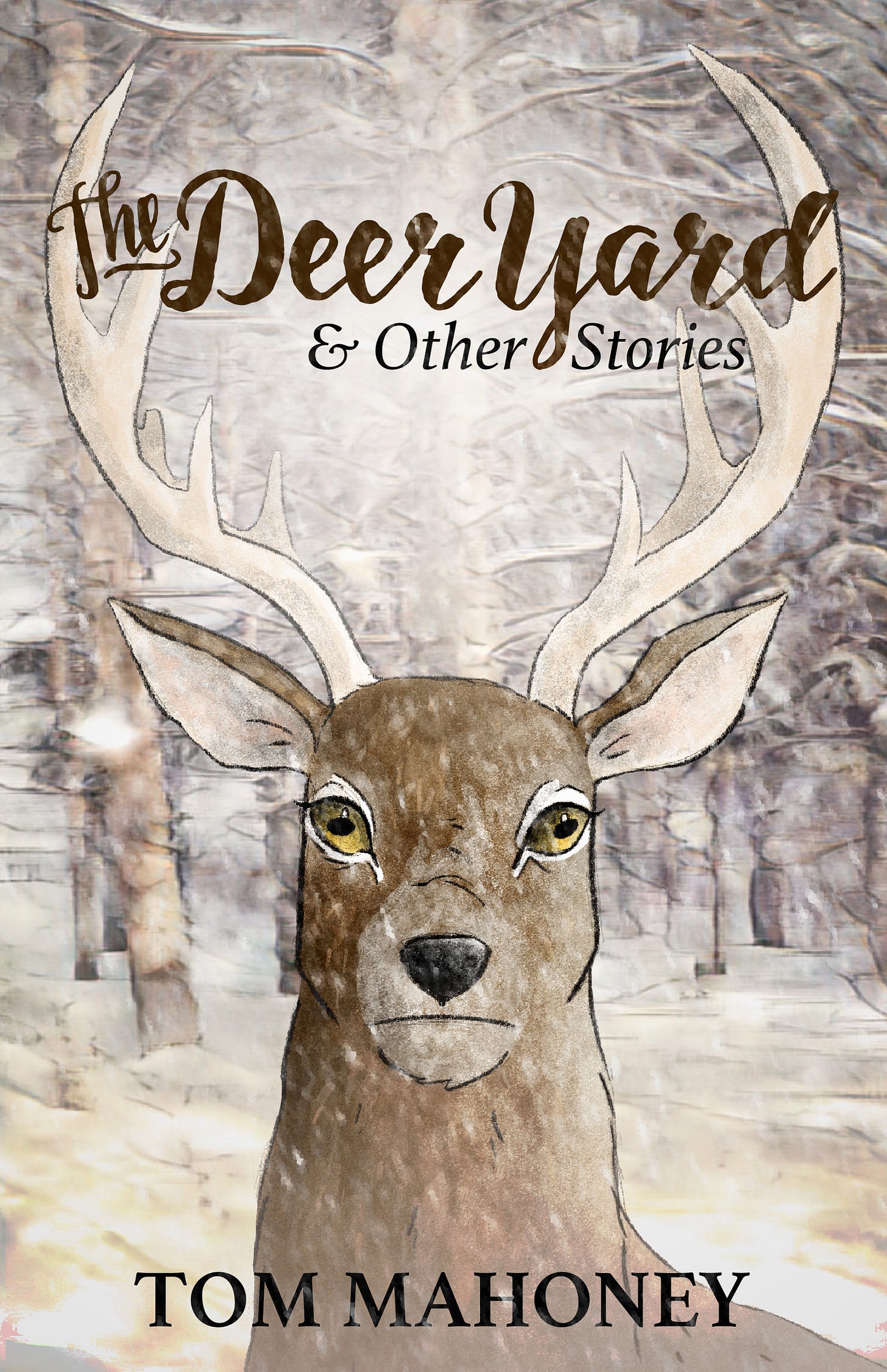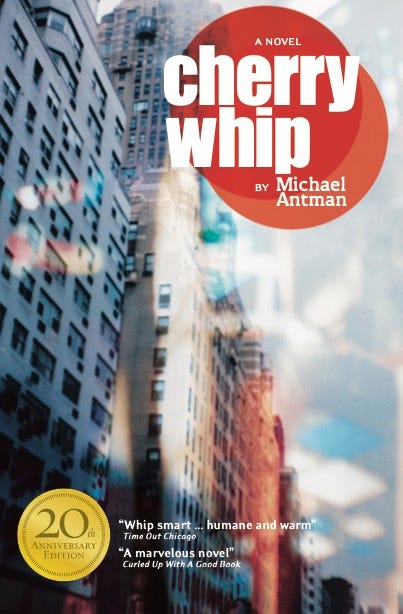Adventures in Publishing (Part Three)
The Deer Yard and Other Stories by... Dad
Being the 64th edition of Assorted Nonsense, the official newsletter of Donovan Street Press Inc.
On We Go
For those just tuning in, this is part three of a casual but comprehensive look back on Donovan Street Press’s journey so far. In part one I wrote about the publication of Other Times and Places, the first book published under the Donovan Street banner. In part two I covered the publication of my first novel, A Time and a Place, when I acquired the rights back after its original publisher folded.
Et voila… part three:
The Deer Yard and Other Stories
My father, Tom Mahoney, was really the first author in the family. He bought a typewriter when I was a kid (I loved that typewriter; I can still smell it) and starting cobbling together short stories. A local writers group on Prince Edward Island helped encourage him, and sometimes one or two of his stories wound up in local self-published collections.

He’d write a draft of a story and then hand it to me or one of my sisters with unmistakeable glee and say, “What do you think of this?” and we’d give him some feedback and encourage him to write more.
There were funny stories about dogs, and bears in the wrong place at the wrong time, and depositing drunken farmers on the doorsteps of angry wives and bullies harrassing strawberry pickers and demon dogs on bridges and skiing over deer buried in snow and corrupt rural veterinarians and plenty more. Every story was based on some grain of truth. The grammar and punctuation sometimes left a bit to be desired but the storytelling prowess always shone through.
Over the years I acquired different versions of Dad’s stories in different formats, print copies, version on floppy discs, Word files, and so on. My mother encouraged me to do something with them. I wanted to do something with them, but I didn’t know what, and as an adult I was pretty focussed on my own writing in between all my other work and family responsibilities.
But after self-publishing a collection of my own short stories and a version of my novel A Time and a Place (after re-acquiring the rights) it was pretty clear what I needed to do. Now that I knew how to do it, and self-publishing had (at long last) acquired a veneer of respectability, I needed to publish a collection of Dad’s stories. I think Dad was 86 years old when I took on the task (and 87 when I finished it). He was still in pretty good health but a part of my thinking was to get the job done while he was still young enough to enjoy the fruits of his labours.
I set about tracking down every version of all his stories. I scoured hard drives and filing cabinets. Relatives sent versions of stories. Together Dad and I decided which stories belonged in the collection, and then, with the help of my sisters, I set about editing them all.
The editing process took about three months. I really felt like each story was a diamond in the rough. Like many talented but unprofessional writers, Dad didn’t really have a handle on grammar or punctuation. But it didn’t matter. That’s what I was for. I tried not to change the actual writing unless something didn’t make sense. As I cleaned up the prose and punctuation, the stories began to really shine.
I am fanatical about typos. (Yes, I know they sneak into this newsletter from time to time but I usually catch and correct them eventually.) My objective is always to make whatever I publish at least as good as anything out of the so-called Big Five publishers (Penguin Random House, HarperCollins, Macmillan, Hachette Book Group, and Simon & Schuster). I think this is essential. Non-negotiable. Indie publishing is already behind the eight ball competing with the Big Five; Indie writers and publishers have to do whatever they can to level the playing field. Well, not level it, maybe; but tilt it as far as we can in our favour.
We have more power in this regard than we think. There is absolutely no reason indie manuscripts can’t be typo free with proper grammar and punctuation. That is within our control. That’s simply a matter of expert editing. And not just that but correcting mistakes as we find them, even after the book has been published. Also within our control is the quality and range of the stories we can make available, along with the quality of the books themselves, including the covers. Attempting to make Dad’s book an example of this, my sisters and I scoured Dad’s stories to correct mistakes and eliminate typos.
Dad and I decided together which of his stories to include. There was one story I would have liked to include but Dad thought it could embarrass the descendants of the people it was about. No question; Dad was the final arbiter here. We removed the story.
I realized that the tales could be arranged in chronological order as the protagonist aged. As I’ve mentioned, all the stories contained at least a grain of truth. Many of them, but not all, were told from Dad’s point of view. Those that weren’t were usually from the POV of one of Dad’s brothers. For the purposes of the collection, I realized that we could pretend that the protagonist was the same in many of the stories. I felt this would strengthen the collection by giving it a solid through-line: it would become a chronological series of stories about a young man born and raised in northern New Brunswick, from a child to a grown man.
So, with Dad’s permission, I made the main character’s name Tim in every story where it made sense to do so (Timmy when he’s a boy). It was close enough to Dad’s real name, Tom, to suggest that the stories could be about him while just far enough away from his real name to underscore that although there was some truth to each story, they shouldn’t be taken literally. I made his last name Kilfoil, which is my maternal mother’s maiden name (Helen Kilfoil).
The Deer Yard became the first story in the collection. I thought this made sense because Timmy is at his youngest in that story. And I liked it as a title: The Deer Yard and Other Stories. I thought it would make for a terrific cover: a deer staring out at us from the woods. I asked my daughter Erin if she would draw the deer. She agreed for the paltry sum of $100 (yes, I exploited my daughter, but I do make it a point to pay her and my other daughter Keira increasingly large sums for their illustrations as time goes on and the company can afford it). Erin came up with the fantastic looking deer you see below:
My sister Susan (also a writer) recommended a book designer with whom she’d worked by the name of Valerie Bellamy, a graphic designer who did contract work on the side. Valerie took Erin’s illustration and worked up three possible backgrounds. That’s the final version above. I don’t care what anybody else thinks of it; I love it. I think it works. That cover has sold a fair amount of books. I have had people not even crack open the book and buy it based on the cover alone. I paid Valerie a $155.38 CAD deposit for the cover design and another $245.78 CAD once the work was done, for a total of $401.16 for the final files.
(I just found out recently, to my utter shock, that Valerie passed away this past December 2024, way too young. My sincere condolences to her family and friends.)
I decided to format the book myself. Not because I had any issues with my previous book designers; quite the contrary, but because let’s face it: I’m a control freak. I keep tweaking and correcting the texts of the books I publish until they’re perfect, even (as I’ve mentioned), after they’ve been published, if necessary. And I hate bugging book designers to make changes once they’ve already delivered what’s supposed to have been the final files. To be clear, every book designer I’ve ever worked with has insisted that they don’t mind, but I’m always uncomfortable pestering them. Better to be in a position to make the corrections myself.
So I purchased a program called Vellum to format my books myself. A lot of professionals use Adobe InDesign; it’s the gold standard, and I do like Adobe Creative Suite products. I’m fairly fluent in Adobe Premiere for film editing, for example. But I don’t like the subscription model Adobe uses which requires you to essentially pay for the product forever. And the truth is Adobe InDesign is more than I require for many of the books I publish. The general reading public neither knows nor cares whether the book they’re reading was formatted on InDesign or Vellum. And the fact is Vellum is capable of producing quite attractive, eminently readable books. (Later I’ll tell you about writing and designing my memoir Adventures in the Radio Trade, a book that I felt benefited from a detailed index. That would be an example of a book beyond Vellum’s capabilities. But Vellum was perfectly capable of handling my father’s The Deer Yard and Other Stories.)
Vellum cost me $351.69 CAD. But the beauty of Vellum is that it was a one time expense. Now I own the program and all its upgrades as long as it’s supported, which I expect will be for as long as I need it, and I can use it for however many books I wish to publish in the future (as long as they don’t have fancy indexes).
I chose and tweaked one of Vellum’s styles called Artisanal. I made the book a 6 x 9” trade paperback, mainly because that’s what I was familiar with at that point. (I prefer 5.5 x 8.5” now… a little smaller, easier to handle. I would like to experiment with other sizes and formats in the future.)
Dad had one request: make the font large enough so that he could read it easily. Remember, he was 87 years old at the time. So, employing the Iowan Old Style font, I made the text expecially large, and published The Deer Yard and Other Stories officially as a large print edition. Dad was pleased with the result.
My sister Susan wrote a nice introduction to the collection, which we excerpted on the back jacket, and published The Deer Yard and Other Stories on December 9th, 2021. We listed the publisher as “Donovan Street Press in association with Bluemountain Entertainment.” Bluemountain Entertainment is my sister Susan’s production company. Both companies were not incorporated at the time but have since been incorporated.
At the time of publication, The Deer Yard and Other Stories cost $852.85 to make. That included cover design, illustration, and book formatting software. The editing was free, mostly me with help from my sisters. The first batch of author’s copies to sell cost $133.59.
The Deer Yard and Other Stories received a favorable review from Robert Runte writing for the Ottawa Review of Books, who called it “…more than merely a good read.” My favourite bit in his review was this:
“My favourite was the perfectly structured “Next in Line”, about the town’s cold case. Our protagonist awaits his turn at the barber’s while each of the preceding customers contributes their first-hand experience of the now long-missing victim of a probable murder. If I were teaching structure, pacing, atmosphere or point of view to a writing class, I might well choose this as my exemplar.”
One of my father’s brothers had told Dad that story over the phone based on his own experience at a barber shop, and Dad transmuted it into Next in Line.
According to Amazon Book Report, which is a great little tool for reporting book revenue and sales from multiple vendors, The Deer Yard and Other Stories has earned $600.31 from 101 sales at Amazon.ca, Amazon.com, Kobo, Apple, Amazon.co.uk, and “other” since its publication. I’ve hand sold at least another 159 since then for an additional $3975 or thereabouts. Mom and Dad and Susan have sold more; I don’t know their numbers. Authors copies purchased over the years cost $1076.43. Some of those went to Mom, Dad and Susan to sell and like I said I don’t know how much they made; we all bought our own authors copies and shared them back and forth and everybody did their own accounting. But based on my numbers alone, The Deer Yard and Other Stories has sold at least 260 copies and earned at least $4575.31, for a total profit after expenses of $2646.03.
(My business manager, Jenn DeLagran, was not a part of the operation at that time. Had she been, my numbers would be completely reliable. But I think they’re still pretty much in the ballpark.)
That’s actually pretty good for a book by a brand new indie press by an unknown, 87 year old author, and I think makes it Donovan Street Press’s most successful book so far (in terms of profit, at least: A Time and a Place has sold more copies, but marketing and other dubious decisions have cut into that profit). Guaranteed Dad made a profit because he didn’t do anything foolish like pay for dumb marketing or paid reviews. I bore all the expense, made my money back, and made sure to give Dad his fair share (which I still do as the book continues to sell). Mom and Dad earned even more by selling copies of the books themselves, and so did Susan and her company Blue Mountain Entertainment.
On the 29th of March, 2022, at the Summerside Mayor’s Heritage Tea, which took place at Summerside’s City Hall, Mayor Basil Stewart presented Dad with “a Cultural Activities Award for the 2021 publication of his book, The Deer Yard and Other Stories,” telling all assembled that “Mahoney published the book of stories, which are both fiction and memoir, at the age of 87. The book has been a consistent seller on Amazon ranking in the top ten of the best sellers in Canadian short stories.”

I put the book together for Dad because I’d always wanted to do something with his stories and I finally knew how. It felt really good to do it and it’s been blindingly obvious ever since that Dad super appreciated it. If I never do anything else of value in this misbegotten life, at least I will have done that for my Dad. Saint Peter might still not let me into heaven on the grounds that I’m just too damned ugly (or sundry other crimes) but “at least you did that” I’m sure he’ll concede.
It was still not, at that time, my intention to start a publishing company. And yet my budding company already had three titles to its name: Other Times and Places, A Time and a Place, and The Deer Yard and Other Stories.
Maybe it was time to get serious about this whole publishing company thing.
More on that next time.
Stay tuned for the next step in the evolution of Donovan Street Press Inc. in a future edition of this newsletter.
Cherry Whip
by Michael Antman
The funny and tragic story of a Japanese jazz musician's first encounter with America, presented here in its 20th Anniversary edition. A young man who overthinks everything but doesn't understand himself, Hiroshi encounters unexpected adversity and faces destruction unless he can figure out who he really is. Hiroshi's struggle for self-acceptance is a tale with universal resonance.
The 20th Anniversary edition of a novel whose reputation has continued to grow over the years.
Praise for Cherry Whip:
"Whip smart... humane and warm" ~ Time Out Chicago
"A marvellous novel" ~ Curled Up With A Good Book
"Moving and sexy and funny in fresh ways" ~ Jay Rubin, Editor, The Penguin Book of Japanese Short Stories and translator of Haruki Murakami's The Wind-Up Bird Chronicle
"A terrific and fascinating character study" ~Estella's Revenge
Michael Antman is the author of the novels Cherry Whip and Everything Solid Has a Shadow and the co-author, with Irina Velitskaya, of the forthcoming novel A Distant Place of Slaughter. He is an urban photographer, poet, and book and theatre critic, and a two-time finalist for the National Book Critics Circle's Nona Balakian Award for Excellence in Reviewing. He is the former Global Head of Marketing for a Fortune 100 Company. He lived in Japan for two and a half years, and now makes his home in Chicago.
Thanks for reading!
Follow Joe Mahoney and Donovan Street Press Inc. on: Goodreads, Bluesky, Threads, Mastadon, Facebook, and Instagram
This has been the 64th edition of Assorted Nonsense, the official newsletter of Donovan Street Press Inc.





Congratulations to you and your father. The story-telling gene in the Mahoney family may be similar to the one carried by the Spencers.